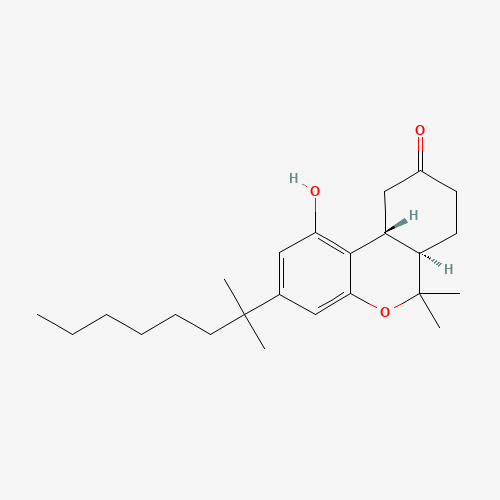| Pharmaceutical Information |
| Drug Name |
Nabilone |
| Drug ID |
BADD_D01510 |
| Description |
Nabilone (marketed as Cesamet) is a synthetic form of delta-9-tetrahydrocannabinol (Δ⁹-THC), the primary psychoactive component of cannabis (marijuana). Although structurally distinct from THC, nabilone mimics THC's structure and pharmacological activity through weak partial agonist activity at Cannabinoid-1 (CB1R) and Cannabinoid-2 (CB2R) receptors, however it is considered to be twice as active as Δ⁹-THC. Nabilone is approved by the FDA for the treatment of nausea and vomiting associated with cancer chemotherapy in patients who have failed to respond adequately to conventional antiemetic treatments [FDA Label].
Tetrahydrocannabinol (THC) and cannabidiol (CBD) are the two most abundant cannabinoids found naturally in the resin of the marijuana plant, both of which are pharmacologically active due to their interaction with cannabinoid receptors that are found throughout the body [A32830]. While both CBD and THC are used for medicinal purposes, they have different receptor activity, function, and physiological effects. If not provided in their activated form (such as through synthetic forms like Nabilone or [DB00470]), THC and CBD are obtained through conversion from their precursors, tetrahydrocannabinolic acid-A (THCA-A) and cannabidiolic acid (CBDA), through decarboxylation reactions. This can be achieved through heating, smoking, vaporization, or baking of dried unfertilized female cannabis flowers.
From a pharmacological perspective, Cannabis' diverse receptor profile explains its potential application for such a wide variety of medical conditions. Cannabis contains more than 400 different chemical compounds, of which 61 are considered cannabinoids, a class of compounds that act upon endogenous cannabinoid receptors of the body [A32584]. The endocannabinoid system is widely distributed throughout the central and peripheral nervous system (via the Cannabinoid Receptors CB1 and CB2) and plays a role in many physiological processes such as inflammation, cardiovascular function, learning, pain, memory, stress and emotional regulation, and the sleep/wake cycle among many others [A32824]. CB1 receptors are found in both the central and peripheral nervous system, and are most abundant in the hippocampus and amygdala, which are the areas of the brain responsible for short-term memory storage and emotional regulation. CB2 receptors are mainly located in the peripheral nervous system and can be found on lymphoid tissue where they are involved in regulation of immune function [A32676].
In Canada, the United States, the United Kingdom and Mexico, nabilone is marketed as Cesamet. It was approved in 1985 by the United States FDA for treatment of chemotherapy-induced nausea and vomiting that has not responded to conventional antiemetics. Though it was approved by the FDA in 1985, the drug only began marketing in the United States in 2006. It is also approved for use in treatment of anorexia and weight loss in patients with AIDS.
Nabilone is a racemate consisting of the (S,S) and the (R,R) isomers. |
| Indications and Usage |
Nabilone is indicated for the treatment of the nausea and vomiting associated with cancer chemotherapy in patients who have failed to respond adequately to conventional antiemetic treatments. This restriction is required because a substantial proportion of any group of patients treated with Nabilone can be expected to experience disturbing psychotomimetic reactions not observed with other antiemetic agents. |
| Marketing Status |
approved; investigational |
| ATC Code |
A04AD11 |
| DrugBank ID |
DB00486
|
| KEGG ID |
D05099
|
| MeSH ID |
C011941
|
| PubChem ID |
5284592
|
| TTD Drug ID |
D0L7AS
|
| NDC Product Code |
73548-2162; 0187-1231; 49812-0156 |
| UNII |
2N4O9L084N
|
| Synonyms |
nabilone | nabilone, (6aR-trans)-isomer | Cesamet | nabilone, (cis-(+-))-isomer | nabilone, (trans-(+-))-isomer | Lilly 109514 | LY 109514 | nabilone, (6aS-trans)-isomer |
|
| Chemical Information |
| Molecular Formula |
C24H36O3 |
| CAS Registry Number |
51022-71-0 |
| SMILES |
CCCCCCC(C)(C)C1=CC(=C2C3CC(=O)CCC3C(OC2=C1)(C)C)O |
| Chemical Structure |

|
|
| ADRs Induced by Drug |
|
|
*The priority for ADR severity classification is based on FAERS assessment, followed by the most severe level in CTCAE rating. If neither is available, it will be displayed as 'Not available'.
**The 'Not Available' level is hidden by default and can be restored by clicking on the legend twice.
|
|
|

